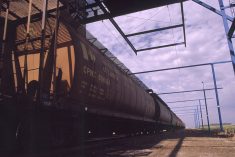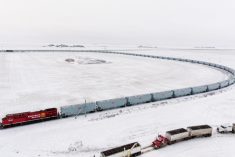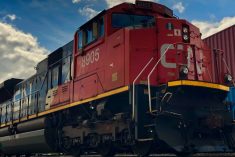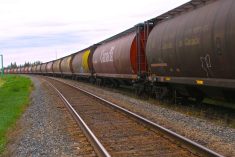The Western Grains Research Foundation (WGRF) can soon expect a late gift of over $4.4 million in surplus Prairie grain freight revenue, according to a new ruling from the Canadian Transportation Agency.
The agency said Dec. 22 it has determined Canadian Pacific Railway (CP) and Canadian National Railway (CN) went over their maximum revenue entitlements (MREs) for Prairie grain by $3,386,483 and $1,041,913 respectively during the 2015-16 crop year.
The two railways’ respective MREs for 2015-16 had been set at $677,879,839 and $684,749,693.
CP and CN now have 30 days to pay their overages to the WGRF, which has been the mandated beneficiary for such payments under the Canada Transportation Act since 2000. The railways also must pay five per cent penalties of $169,324 and $52,096 respectively, the CTA said.
Read Also

India slaps 30 per cent import duty on yellow peas
India has imposed a 30 per cent duty on yellow pea imports with a bill of lading date on or after Nov. 1, 2025.
CN’s overage for 2015-16 is its third in a row, after it topped its MREs by 0.9 and 0.7 per cent in 2014-15 and 2013-14 respectively. CP’s grain revenue came in 0.3 per cent over its MRE in 2014-15, and 0.3 per cent below its MRE in 2013-14.
The two railways together moved 40,393,402 tonnes of Prairie grain in 2015-16, down 2.2 per cent from their total volume in 2014-15, the CTA said. Their combined average length of haul in 2015-16 was 951 miles, up four from the previous crop year.
CN’s Prairie grain handle in 2015-16 came in at 19,784,579 tonnes, with an average haul of 1,015 miles. CP’s handle in the same crop year was 20,608,823 tonnes, with an average haul of 890 miles.
The annual MREs for CN and CP are calculated each year using a formula based on total grain tonnage and average length of haul as well as the Volume-related Composite Price Index (VRCPI).
The VRCPI is an inflation index accounting for forecast changes in the two railways’ costs for labour, fuel, material and capital purchases.
The agency said in April 2015 it would trim the VRCPI for 2015-16 by 5.6 per cent, to 1.2517, based in part on a sharper-than-expected drop in fuel costs.
Specifically, the CTA said at the time, it had “over-forecasted” the expected change in the railways’ fuel costs for 2014-15, based on “third-party” outlooks for crude oil prices and the value of the Canadian dollar.
In April 2016, however, the CTA bumped up the 2015-16 VRCPI by 0.8 per cent, to 1.2668, after CN sought an adjustment.
CN had applied for the change earlier that month, the agency said at the time, based on a company commitment to obtain over 1,700 hopper cars from its U.S. subsidiaries.
Those U.S. cars, CN said at the time, were to be pressed into regulated grain service as replacements for withdrawn federally-owned hopper cars in Canada. — AGCanada.com Network












